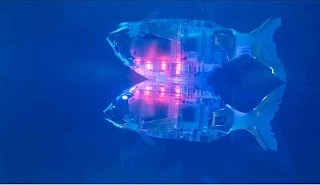Robot Fish Is Going To Revolutionize Ocean Research
Humans have been taking inspiration from nature in technology since long ago. Early airplanes were modeled after birds.
The inventor of velcro got his idea after seeing thorns stuck in the fur of pet dogs. In recent times, seafaring engineers have been drawing inspiration from an animal that is most adept at this task. He is a fish.
Researchers around the world are working on new types of robots that look like fish. Even robots swim like fish.
Researchers say this aquatic automation will be cheap as well as easy to use. These robotic fish are better suited to aquatic environments than the remotely operated vehicles (ROVs) currently used in underwater research.
We may soon see a robot fish revolution if some of the technical issues are resolved.
What Do Robot Fish Do?
Over the past few decades, engineers have been developing prototypes of robotic fish for a variety of purposes. Some of these may be used for specific tasks. For example to fool other fish in the laboratory, to use hydrodynamic simulations or to collect plastic from the ocean. However, it is most commonly used to collect data by navigating the oceans.
These migratory robot fish are usually equipped with video cameras, so that the fish can record encounters with other animals. Besides, they are also equipped with sensors to check the depth, temperature and acidity of the water. Some robots, such as the CIA-built catfish robot named ‘Charlie’, can collect and store water as samples.
Today’s modern ROVs can do these things, and more. However, robotic fish are going to be the big technology of the future. But why?
ROV Vs Robot Fish
“Robotic fish can do the same thing as current ROVs,” said Weicheng Cui. Cui, a marine engineer from Westlake University in China. He also said, “What cannot be done with the current ROV, that work may be done with the help of robotic fish.”
Since the first tethered ROV, the Poodle, arrived in 1953, scientists have been using ROVs to study every part of the ocean. The most commonly used are areas that are too deep and dangerous for scuba divers. ROVs can go deep, where no divers can reach. ROVs can spend endless time there and retrieve live or dead samples from the ocean floor.
While model ROVs are a boon for research, most models are large and expensive. ROVs used by scientific institutions such as the Monterey Bay Aquarium Research Institute (MARI), the Woods Hole Oceanographic Institute, the Schmidt Ocean Institute and OceanX weigh about the same as a rhinoceros. And they cost millions of dollars.
Cranes are needed to operate all such large-sized ROVs. And it has to be attached to a big ship until it is lowered into the water.
On the other hand, the robot fish is a battery-powered bot that weighs only a few kilograms and costs only two thousand dollars.
Fish Vs Robot Fish
Most robot fish look neutral or plain in color, but resemble real fish in their physical structure.
Some robot fish are also colored like real fish. But according to Sam Loong Yu, an engineer at the University of Bristol in England, even the most unrealistic-looking robot fish is better for the ocean environment than ROVs.
While the ROV uses propellers to move through the water, the robotic fish can swim like real fish. Fish can move silently through the water by moving their tails back and forth. And does not cause inconvenience to any other animals or plants in the water. As a result, researchers can get an accurate understanding of the underwater natural environment.
Because the robotic fish are small and tough, scientists can use them to study sensitive species, such as those that live in hidden places like coral reefs, lava tubes or undersea caves.
The Robot Fish Problem
There is one problem though. While robot fish can be handled very well, their range is not great. The batteries of the fish can last only a few hours as they do not receive any electrical power from the main vessel.
However, robotic fish technology needs to go a few steps further in order to completely disable today’s ROVs. For example, they must have docking stations, so that they can charge their batteries by themselves.
The Future
Marine engineer Cui envisions a future where shoals of tiny robotic fishes roam together and do all the hard work with them. These fish will swarm themselves and charge the battery from the underwater docking station. The source of that battery will also be a renewable energy source like wave energy.
“Instead of one ROV, we can use many robotic fish,” Cui said. Using them will greatly increase the efficiency of deep sea exploration.”
However, this possibility is highly dependent on the development of automatic underwater charging stations. Cui and his colleagues are optimistic, however, that the station is feasible with current technology. Cui said the prospect of robotic fishing could become a reality within a decade, if there is enough demand for it.
But convincing scientists to use robotic fish shoals instead of ROVs, says Paul Clarkson, will be a challenge. Paul Clarkson is director of husbandry operations at the California Monterey Bay Aquarium.
He said, “We have been using remote controlled vehicles developed and operated by our research and technology partner MBARI for many years. Their ROVs are an integral part of our work and research, and the capabilities of these instruments make them even more important to us.”
“Even then, with the threat of climate change, habitat destruction, overfishing and plastic pollution, we need to think about how new innovations can help us understand this changing world,” he added.



